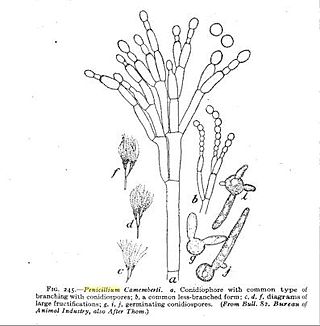
Penicillium is a genus of ascomycetous fungi that is part of the mycobiome of many species and is of major importance in the natural environment, in food spoilage, and in food and drug production.

Penicillium roqueforti is a common saprotrophic fungus in the genus Penicillium. Widespread in nature, it can be isolated from soil, decaying organic matter, and plants.

Penicillium camemberti is a species of fungus in the genus Penicillium. It is used in the production of Camembert, Brie, Langres, Coulommiers, and Cambozola cheeses, on which colonies of P. camemberti form a hard, white crust. It is responsible for giving these cheeses their distinctive flavors. An allergy to the antibiotic penicillin does not necessarily imply an allergy to cheeses made using P. camemberti.
Mycotoxicology is the branch of mycology that focuses on analyzing and studying the toxins produced by fungi, known as mycotoxins. In the food industry it is important to adopt measures that keep mycotoxin levels as low as practicable, especially those that are heat-stable. These chemical compounds are the result of secondary metabolism initiated in response to specific developmental or environmental signals. This includes biological stress from the environment, such as lower nutrients or competition for those available. Under this secondary path the fungus produces a wide array of compounds in order to gain some level of advantage, such as incrementing the efficiency of metabolic processes to gain more energy from less food, or attacking other microorganisms and being able to use their remains as a food source.
Orsellinic acid, more specifically o-orsellinic acid, is a phenolic acid. It is of importance in the biochemistry of lichens, from which it can be extracted. It is a common subunit of depsides.

Penicillium chrysogenum is a species of fungus in the genus Penicillium. It is common in temperate and subtropical regions and can be found on salted food products, but it is mostly found in indoor environments, especially in damp or water-damaged buildings. It has been recognised as a species complex that includes P. notatum, P. meleagrinum, and P. cyaneofulvum. Molecular phylogeny has established that Alexander Fleming's first discovered penicillin producing strain is of a distinct species, P. rubens, and not of P. notatum. It has rarely been reported as a cause of human disease. It is the source of several β-lactam antibiotics, most significantly penicillin. Other secondary metabolites of P. chrysogenum include roquefortine C, meleagrin, chrysogine, 6-MSA YWA1/melanin, andrastatin A, fungisporin, secalonic acids, sorbicillin, and PR-toxin.
Medicinal fungi are fungi that contain metabolites or can be induced to produce metabolites through biotechnology to develop prescription drugs. Compounds successfully developed into drugs or under research include antibiotics, anti-cancer drugs, cholesterol and ergosterol synthesis inhibitors, psychotropic drugs, immunosuppressants and fungicides.
Penicillium coprobium is an anamorph fungus species of the genus of Penicillium which produces pyripyropene A, roquefortine C, penicillic acid and patulin.
Penicillium dendriticum is an anamorph species of the genus of Penicillium which produces Secalonic acid D and Secalonic acid F.
Penicillium dipodomyicola is a species of the genus of Penicillium which produces peniphenone A, peniphenone B, peniphenone C, peniphenone D, cyclopiazonic acid and patulin.
Penicillium discolor is a species of the genus of Penicillium which occurs in nuts, vegetables and cheese and produces chaetoglobosins, palitantin, cyclopenin, cyclopenol, cyclopeptin, dehydrocyclopeptin, viridicatin and viridicatol.
Penicillium allahabadense is an anamorph species of the genus of Penicillium which produces rugulosin.
Penicillium madriti is an anamorph species of the genus of Penicillium which produces orsellinic acid.
Penicillium ochrochloron is a species of fungus in the genus Penicillium which produces penitrem A.
Penicillium oxalicum is an anamorph species of the genus Penicillium which was isolated from rhizosphere soil of pearl millet. Penicillium oxalicum produces secalonic acid D, chitinase, oxalic acid, oxaline and β-N-acetylglucosaminidase and occurs widespread in food and tropical commodities. This fungus could be used against soilborne diseases like downy mildew of tomatoes
Penicillium thomii is an anamorph species of fungus in the genus Penicillium which was isolated from spoiled faba beans in Australia. Penicillium thomii produces hadicidine, 6-methoxymelline and penicillic acid
Penicillium tulipae is a species of fungus in the genus Penicillium which produces penicillic acid, roquefortine C, roquefortine D, terrestric acid, glandicoline A, glandicoline B, meleagrin, oxaline, penitrem A and epineoxaline.
Penicillium verrucosum is a psychrophilic fungus which was discovered in Belgium and introduced by Dierckx in 1901. Six varieties of this species have been recognized based primarily on differences in colony colour: P. verrucosum var. album, P. verrucosum var. corymbiferum, P. verrucosum var. cyclopium, P. verrucosum var. ochraceum, P. verrucosum var. melanochlorum and P. verrucosum var. verrucosum. This fungus has important implications in food, specifically for grains and other cereal crops on which it grows. Its growth is carefully regulated in order to reduce food spoilage by this fungi and its toxic products. The genome of P. verrucosum has been sequenced and the gene clusters for the biosyntheses of its mycotoxins have been identified.
Penicillium commune is an indoor fungus belonging to the genus Penicillium. It is known as one of the most common fungi spoilage moulds on cheese. It also grows on and spoils other foods such as meat products and fat-containing products like nuts and margarine. Cyclopiazonic acid and regulovasine A and B are the most important mycotoxins produced by P. commune. The fungus is the only known species to be able to produce both penitrem A and roquefortine. Although this species does not produce penicillin, it has shown to have anti-pathogenic activity. There are no known plant, animal or human diseases caused by P. commune.

Penicillium spinulosum is a non-branched, fast-growing fungus with a swelling at the terminal of the stipe (vesiculate) in the genus Penicillium. P. spinulosum is able to grow and reproduce in environment with low temperature and low water availability, and is known to be acidotolerant. P. spinulosum is ubiquitously distributed, and can often be isolated from soil. Each individual strain of P. spinulosum differs from others in their colony morphology, including colony texture, amount of sporulation and roughness of conidia and conidiophores.




